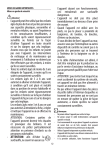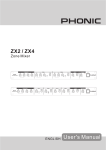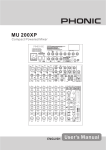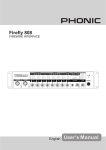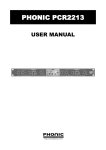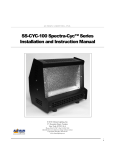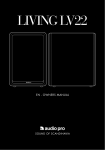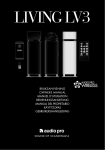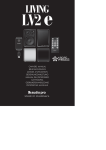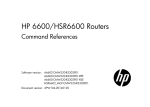Download SUPRACURVE
Transcript
$ 6835$&859( (1*/,6+ SupraCurve A6600 TABLE OF CONTENTS INTRODUCTION ................................4 FEATURES ........................................4 GETTING STARTED..........................4 FRONT PANEL DESCRIPTION.......5 REAR PANEL DESCRIPTION.........6 TYPICAL GRAPHIC EQUALIZER OPERATION ......................................7 BLOCK DIAGRAM............................8 DIMENSIONS.....................................9 SPECIFICATIONS............................10 APPENDIX .......................................11 INTRODUCTION / FEATURES / GETTING STARTED INTRODUCTION GETTING STARTED Congratulations on your purchase of the A6600 SUPERCURVE, a dual 31-band graphic equalizer. In order to get the best performance from your A6600 SUPERCURVE, please read this user’ s manual carefully and keep it for future reference. ●30mm sound system with care, and do not share sockets or grounding with light dimmers. balanced lines wherever possible. If feasible, cross low noise, high-quality performance audio and lighting cables at right angles to minimize the possibility of interference. Keep unbalanced cables as short as possible. VR for precise adjustment ●Switchable The unit must be properly grounded to avoid electrical shock to the operator. Choose the main supply for the 2 Separate audio cables from dimmer wiring, using FEATURES ●Extremely 1 Check the AC voltage before connecting the plug. boost/cut range: 6dB and 12dB 3 Check your cables regularly and label each end for easy identification. ●EQ IN/OUT switch ●Center-dented ●Illuminated ●+/-15dB 4 Before switching on the main power, set the input level control to its minimum setting. Doing so will sliders prevent excessive noise caused by bad level adjustment, faulty wiring, defective cables, or bad connections. buttons and faders input gain range for easy level matching 5 Always turn the unit on before turning on the ● 8-segment LED input level display with CLIP warning ●Dual variable 15Hz to 400Hz LOW CUT filter and 2.5KHz to 30KHz HIGH CUT filter ●Auto relay-controlled bypass ●Balanced ●1/4" power amplifier; always turn it off after turning off the amplifier. 6 Always turn off the main power before connecting or disconnecting the unit. 7 Never use solvents to clean the unit. Clean the unit with a soft, dry cloth. inputs and outputs TRS and XLR connectors ●Shielded toroidal power transformer for low noise interference Page 4 A6600 USER’S MANUAL PHONIC CORPORATION FRONT PANEL DESCRIPTION 3 1 2 -24 -18 -12 -6 1 4 5 6 0 +6 12 CLIP +12/+6 0 FILTER RANGE 20 -24 -18 -12 -6 2 -12/-6 0 +6 A6600 +15 0 -12/-6 25 31.5 40 50 63 12.5K 16K 20K 12 CLIP EQ IN +12/+6 SupraCurve 12dB 6dB INPUT +12/+6 EQ IN 0 dB -15 7 +12/+6 0 dB 12dB 6dB 0 0 -12/-6 -15 +15 INPUT FILTER -12/-6 RANGE FRONT PANEL DESCRIPTION The operations of channel 1 & channel 2 are exactly the same. 1 INPUT level control The INPUT level control allows you to adjust the input signal level (volume). 2 LEVEL METER with CLIP LED The LEVEL METER provides instant monitoring of output signal level. To avoid possible distortion, reduce the input level if the CLIP LED lights up. For the LED to blink briefly 5 EQ IN button Depress this button to activate the A6600; it will light up yellow. Release it to terminate all A6600 functions, providing an immediate comparison between the original sound and the sound as processed by the A6600. 6 EQ RANGE selector button One benefit of using a graphic equalizer is that the during the loudest parts of your program is acceptable; if it stays on for several seconds, however, distortion may frequency sliders form a graphic depiction of the frequency response curve you have set. When the begin to occur. setting requirements are subtle, however, it may not be easy to identify the curve. If you encounter this difficulty, depress the EQ RANGE selector switch to increase the range of the level settings. 3 LOW CUT FILTER The LOW CUT FILTER allows high frequencies to pass through unchanged while severely attenuating (cutting) very low frequencies. Use this switch to protect your audio system from damaging low-frequency transients (loud thumps). When depressed, the button will light up red and set the range at 6dB. When released, the same button will light up green and set the range at 12dB. 4 HIGH CUT FILTER The HIGH CUT FILTER allows low frequencies to pass through unchanged while effectively attenuating very high frequencies. 7 Illuminated frequency level slider Moving the illuminated slider upward increases the level of the related frequency; moving it downward decreases the level of the related frequency. PHONIC CORPORATION A6600 USER’S MANUAL Page 5 REAR PANEL DESCRIPTION JACK CONFIGURATIONS FOR INPUT JACKS POWER UNBALANCED (+) ( - ) THE RISK OF OT EXPOSE OISTURE. BALANCED CH2 100~120V AC FUSE 500 mA ~100V AC 60Hz ~120V AC 60Hz ~230V AC 50Hz ~240V AC 50Hz OUTPUT (BALANCED) XLR-ASSIGN INPUT (BALANCED) 2 10 1 3 220~240V AC FUSE T315m A 11 CTRIQUE (G) INPUT 9 1: GND 2: + 3: - PUT ANCED) 1 2 3 OUTPUT 8 REAR PANEL DESCRIPTION The operations of channel 1 & channel 2 are exactly the same. 8 INPUT Each channel has an XLR male connector and a balanced 1/4" jack for input connection. 9 OUTPUT Each channel has an XLR female connector and a balanced 1/4" jack for output connection. 10 POWER switch Use this switch to turn the A6600 on and off. Turn the A6600 on before turning on the power amplifier; doing so will prevent loud transients which can damage your speakers and create noises unpleasant for your audience. 11 AC power socket with fuse holder Connect the supplied AC power cord to this socket, then insert the plug into a wall socket of suitable voltage. A blown fuse may be replaced only by a fuse of identical type and rating. Page 6 A6600 USER’S MANUAL PHONIC CORPORATION TYPICAL GRAPHIC EQUALIZER OPERATION MIXER CHANNEL EQUALIZATION TYPICAL GRAPHIC EQUALIZER OPERATION Many mixers provide only simple equalization for individual channels. If your mixer has channel inserts, you can patch your equalizer into a channel that is being used for something important and use it to tailor GENERAL TONE CONTROL The graphic equalizer is a useful device for general tone shaping because it is simple and easy to adjust. The visual reference provided by the slide fader position gives an approximate idea of the frequency response generated: higher frequencies appear on the right, lower frequencies on the left. To use the equalizer, you must know the numerical frequency range of the tone you wish to produce. Here is a frequency range chart for your reference -- it is a useful tool when first using a graphic equalizer. Use the range chart as a guide, then adjust by ear. Unfortunately, even a good equalizer cannot offer a complete solution when a room has severe inherent acoustic problems. Nor can equalization overcome the lack of sound clarity caused by rooms with unduly long reverberation times. FEEDBACK CONTROL In live performance applications, graphic equalization is almost always applied separately to the stage the sound of this channel exactly as you want. LARGE ROOM EQUALIZATION Large rooms tend to suffer from multiple reflections with long time delays and long reverberation intervals -factors which lead to reduced intelligibility and a generally muddy sound. As sound travels long distances, high frequencies attenuate more than low frequencies. In general, a large room benefits from some low frequency roll-off and some high frequency boost. Therefore, reducing the low frequency output may be advantageous in buildings made of concrete or stone, where much of the bass is reflected rather than absorbed. Rolling off the high frequency end above 5kHz may also contribute to a more natural sound. The shape of the optimal house curve varies according to the individual sound system and acoustic environment; a degree of experience is indispensible to achieving the best result. monitor or foldback system to reduce the level of those frequencies that would otherwise cause feedback problems. These problems arise from monitor positioning, sound reflected from the stage walls, and peaks in the frequency response curves of the monitor speaker system. A graphic equalizer can provide some control over moderate feedback problems, but it hasn't enough flexibility or resolution to remedy a severe feedback response. The best results are achieved by eliminating feedback points. One or two feedback points can be eliminated by adjusting the slide faders, but no more than 6dB should be cut. If you find feedback points covering many equalizer bands and cutting every affected band does not help, you must reduce the system gain. The combined use of a graphic equalizer for tone control and a parametric equalizer for feedback control is highly recommended. PHONIC CORPORATION A6600 USER’S MANUAL Page 7 Page 8 1 A6600 USER’S MANUAL 1 CH2 INPUT 2 CH2 INPUT CH1 INPUT 2 CH1 INPUT 3 3 +15V BUFFER BUFFER 20 20 BOOST DR CUT +15V BOOST DR CUT 25 25 40 31 40 INPUT AMP 31 INPUT AMP 50 50 63 63 80 80 100 100 125 125 200 250 315 400 160 200 +6DB +12DB 315 630 400 500 630 EQ2 OF VR LED 1*31 250 500 6/12dB LED EQ1 OF VR LED 1*31 160 +6DB +12DB 6DB LED 1K 800 1K EQ2 800 EQ1 1.6K 2K 2.5K 1.25K 1.6K HIGH CUT 2K 2.5K 3.15K LOW CUT 3.15K LOW CUT HIGH CUT AND LOW CUT 1.25K HIGH CUT HIGH CUT AND LOW CUT 4K 4K 5K 5K 6.3K -15V 6.3K 8K 8K 10K 10K 12.5K 12.5K -15V 16K 16K 20K 20K ON ON EQ IN2 EQ LED EQ IN1 EQ LED CH2_LED CH1_LED RELAY2 RELAY1 CH2 OUT 2 CH1 OUT 2 1 1 CH2 OUT 3 CH1 OUT 3 BLOCK DIAGRAM BLOCK DIAGRAM PHONIC CORPORATION DIMENSIONS PP DIMENSIONS PP PP PHONIC CORPORATION A6600 USER’S MANUAL Page 9 SPECIFICATIONS SPECIFICATIONS INPUT Connectors Impedance XLR & 1/4" TRS balanced, line level (+4 dBu), RF filtered 56k ohms Maximum level OUTPUT +24 dBu balanced and unbalanced Connectors Impedance XLR & 1/4" TRS balanced 100 ohms Maximum level +24 dBu SYSTEM Frequency Response 10 Hz to 35 kHz, +/- 3 dB 20 Hz to 20 kHz, +/- 0.25dB (flat) 20 Hz to 20 kHz, +/- 1 dB (max/min) THD 0.004% typical at +4 dBu, 1 kHz Noise Crosstalk < -87 dB < -80 dB FILTERS Low-cut 15 Hz to 400 Hz variable, -18 dB/oct High-cut EQUALIZER Center Frequency Range CONTROLS & DISPLAY Input Low-Cut Filter High-Cut Filter EQ IN Range Input Level Meter POWER SUPPLY Power Requirement Power Consumption Power Connector Fuse PHYSICAL Enclosure Dimensions (W x H x D) Net Weight Page 10 2.5 kHz to 30 kHz variable, -18 dB/oct ISO Standard 31-band, 1/3 octave, 20 Hz to 20 kHz +/- 6 dB or +/- 12 dB, selectable Adjusts the input gain Determines the low-cut frequency Determines the high-cut frequency Switches between EQ in and bypass Switches the boost/cut range between +/- 6 and +/- 12 dB 8-segment LED meter with clip indicator 100-120 V, 200-240 V, AC 50/60 Hz 15 W Standard IEC receptacle 100-120 V: 1 A / 250 V 200-240 V: 500 mA / 250 V Steel housing with aluminum front panel 483 x 88 x 151 mm (19 x 3.5 x 5.9 in.) 3.2 kg (6.9 lbs.) A6600 USER’S MANUAL PHONIC CORPORATION APPENDIX APPENDIX Phonic recommends the following books for those interested in advanced audio engineering and sound system operation: • "Sound System Engineering" by Don and Carolyn Davis, Focal Press, ISBN: 0-240-80305-1 • "Sound Reinforcement Handbook" by Gary D. Davis, Hal Leonard Publishing Corporation, ISBN: 0-88188-900-8 • "Audio System Design and Installation" by Philip Giddings, Focal Press, ISBN: 0-240-80286-1 • "Practical Recording Techniques" by Bruce and Jenny Bartlett, Focal Press, ISBN: 0-240-80306-X • "Modern Recording Techniques" by Huber & Runstein, Focal Press, ISBN: 0-240-80308-6 • "Sound Advice : The Musician’s Guide to the Recording Studio" by Wayne Wadham, Schirmer Books, ISBN: 0-02-872694-4-0 • "Professional Microphone Techniques" by David Mills Huber, Philip Williams. Hal Leonard Publishing Corporation, ISBN: 0-87288-685-9 • "Anatomy of a Home Studio: How Everything Really Works, from Microphones to Midi" by Scott Wilkinson, Steve Oppenheimer, Mark Isham. Mix Books, ISBN: 091837121X • "Live Sound Reinforcement: A Comprehensive Guide to P.A. and Music Reinforcement Systems and Technology" by Scott Hunter Stark. Mix Books, ISBN: 0918371074 • "Audiopro Home Recording Course Vol 1: A Comprehensive Multimedia Audio Recording Text" by Bill Gibson. Mix Books, ISBN: 0918371104 • "Audiopro Home Recording Course Vol. 2: A Comprehensive Multimedia Audio Recording Text" by Bill Gibson. Mix Books, ISBN: 0918371201 PHONIC CORPORATION A6600 USER’S MANUAL Page 11












